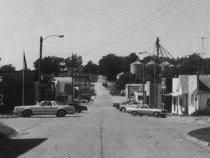Avoca
Cass County
Amos Tefft arrived in Nebraska from Illinois in the spring of 1857 and bought land in this part of Cass County. By September, when his family joined him, Jeremiah Carr had obtained a post office, and in October, a "paper town" was registered by George Vickroy and Masten Redin. The proprietors laid out wide streets, a public square, and called their town "Avoca." This name, also that of the township and the post office, is thought to have been suggested by young Eliza Kirkpatrick for a river in Ireland extolled by the poet, Thomas Moore.
By 1860 there were 18 families living in the area. When the Civil War broke out in 1861, many joined a regiment "to defend the Union," or served in the Nebraska Militia, which formed in 1862. When the war was over, the area filled with settlers, many of German descent.
News about a railroad began circulating in 1881. The branch line of the Missouri Pacific followed the precinct line between land owned by the Tefft family and John Carter. In 1882, after Orlando Tefft successfully negotiated for a station, a town was surveyed and a new plat was filed using the name "Avoca." Tefft, east of the tracks, and Carter on the west, competed to see who could sell the most lots. Tefft got the school, post office, and many businesses, while Carter had the elevator and depot. It was rumored that the MP would build its repair shop at Avoca, but this never occurred.
The first child born in the new town was to Amizah and Mary Smith, who owned the restaurant. Amos Tefft presented them with a silver cup engraved with the child's name, Elmer Avoca Smith. By 1884, more than 150 people lived in Avoca, and later that year incorporation papers were completed.
Early in the 1890s the population is said to have reached 300. A diphtheria epidemic that took many lives, along with the drought and money panic, caused the population to drop to 255 by 1900. Electricity was installed in 1918.
Disaster struck the town in the 1920s. A terrible windstorm hit Avoca and the surrounding area on September 6, 1921. Described as "more cyclonic than tornadic in nature," the school and much of the town were damaged. A second disaster occurred on February 26, 1924, when nine businesses were destroyed in a fire.
The "2nd of July celebration," established about 1910 by the local businessmen, took on a larger scale in the 1920s when the Avoca Woman's Club used the event to raise money for a community library. The population of the town, 222 in 1930, dropped just below 200 during the 1930s.
Natural gas was installed in 1947, and a new water system in 1955. Six blocks of paving were completed by July 2, 1955. By 1960 the population was 218 and growing. Dial telephones replaced the old system in 1963, mercury vapor street lights were installed in 1964, and a new post office was dedicated in 1969.
The highlight of the 1970s was the development of the Avoca Park on land donated on behalf of the Sheldon Tefft family. Under the leadership of Clyde Fletcher and Darrell Brinkhoff, it was transformed into a park using volunteer labor and donated funds. In 1976 a bicentennial flag was raised on the flagpole, a gift to the community by State Senator Calvin Carsten and his family. The dedication ceremony featured Congressman John McCollister.
In 1977 another project, the House Street Bridge over Weeping Water Creek, was completed.
In 1980, with a population of 242, Avoca gained national recognition with its annual "Quack-Off Contest." An idea developed by Marly Hawkinson and Vernon Dettmer invites participants from far and wide. Ducks are raced on the tennis court in the park, which is sometimes flooded for the occasion. By 1992 there were 72 entries and attendance of over 1,000.
Avoca observed its centennial with a three-day celebration in July 1982. Since then, a quick-response team was initiated in 1983 by Patricia Dettmer. It serves the Avoca Rural Fire District. Fund-raisers such as a "Hee Haw Jamboree," extended from 3 to 5 shows, have provided for a better-equipped van. In 1991 citizens approved locally-operated Keno, with profits to go for community betterment.
Now, ten years into our second century, Avoca faces many of the same challenges as do other small towns in the state. Closely linked to the farming economy, the community continues to serve the needs of its citizens, and is hopeful for the future.
By Cindy Steinhoff Drake, Technical Services Librarian at the Nebraska State Historical Society, and a resident of rural Avoca.
ADDITIONAL MATERIAL: The Centennial History of Avoca, NE 1882-1982, by Drake; "Ghost Towns in Cass County Nebraska", Nebraska History Magazine, 18:50 (July 1937); "Pioneer Recalls Avoca as Wheat Field," Pioneer Stories of Cass County, Nebraska, Cass County Historical Society Magazine, 1:1 (1936)' and "Avoca," 1967 Cass County Fair Book by Wolph.


